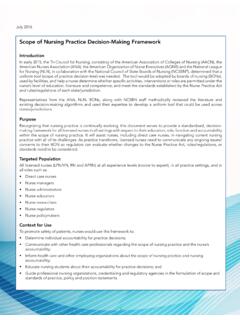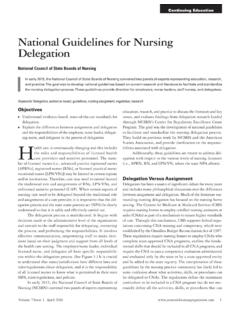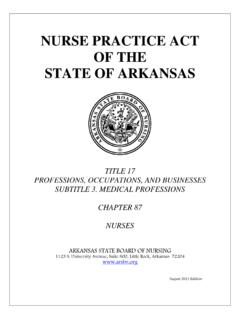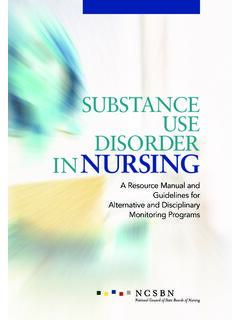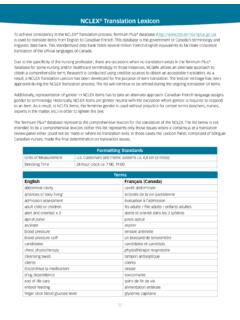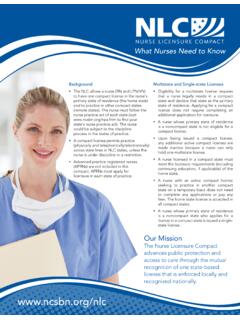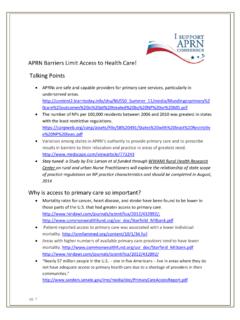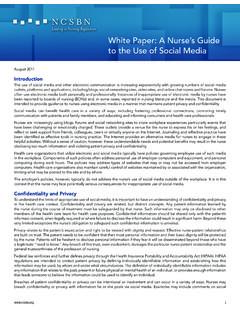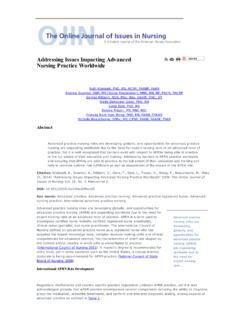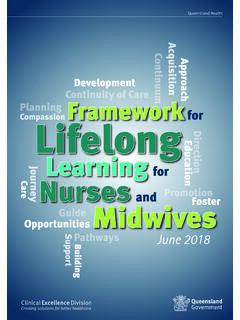Transcription of Nurse Practice Acts Guide and Govern: Update 2017
1 18 Journal of nursing RegulationNurse Practice Acts Guide and Govern: Update 2017 Kathleen A. Russell, JD, MN, RNThe state s duty to protect those who receive nursing care is the basis for a nursing license. That license is an authorization or permission from state government to Practice nursing . The guidelines within the state Nurse Practice act and the state nursing regulations provide the framework for safe, competent nursing Practice . All nurses have a duty to understand their Nurse Practice act and regulations, and to keep up with ongoing changes as this dynamic document evolves and the scope of Practice expands. Keywords: Board of nursing , education standards, licensure, Nurse Practice act, nursing regulation, public protection, scope of practiceLearning Objectives Recall the history of Nurse Practice acts (NPAs).
2 Describe the eight elements of an NPA. Discuss disciplinary action, including grounds and possible actions. Name the ways that licensure status and board of nursing (BON) actions are communicated to the public. Identify the purpose of state involvement in the regulation of nursing a new driver to get behind the wheel of a car requires the driver to know the laws governing driving; however, the laws do not tell the whole story. For example, what is a driver to do when entering an unprotected intersection? What governs the driver s movement into the intersection? How does the driver account for the weather, vehicle, and road condi-tions?
3 What is the driver s knowledge and experience level? Any new driver needs guidance or rules to manage the inherent risks are also a part of nursing . Patients are ill; medications and treatments have benefits and adverse effects; clini-cal situations are undetermined, open ended, and highly variable (Benner, Malloch, & Sheets, 2010, p. 6). Providing nursing care sometimes feels like the new driver navigating that unprotected intersection. As with the new driver, education and standards pro-vided by laws and regulations designed to protect the public pro-vide guidance in nursing Practice . nursing requires specialized knowledge, skill, and indepen-dent decision making: The Practice of nursing involves behavior, attitude and judg-ment, and physical and sensory capabilities in the applica-tion of knowledge, skills, and abilities for the benefit of the client.
4 nursing careers take widely divergent paths prac-tice focus varies by setting, by types of clients, by differ-ent disease, therapeutic approach or level of rehabilitation. Nurses work at all points of service in the health care system (Sheets, 1996). A layperson does not necessarily have access to health profes-sional credentials and he or she does not ordinarily judge whether the care received is delivered according to standards of care. Because health care poses a risk of harm to the public if practiced by professionals who are unprepared or incompetent, licensed pro-fessionals are governed by laws and regulations designed to mini-mize the risk.
5 Additionally, nurses are mobile and sophisticated, and they work in a society that is changing and asymmetrical for consum-ers. The result is that the risk of harm is inherent in the intimate nature of nursing care. Thus, the state is required to protect its citizens from harm (Sheets, 1996). That protection comes in the form of reasonable laws to regulate occupations such as nursing . Consequently, these laws include standards for education, scope of Practice , and discipline of professionals. History of Nurse Practice ActsBefore the Industrial Revolution, individuals could evaluate the quality of services they received. Many communities were small, and everyone knew everyone.
6 Basic needs were met mostly by each family, and when people turned to others, they knew the reputa-tions of those who provided services. At that time, anyone could call themselves a Nurse . However, as technology and knowledge advanced, a variety of people and groups began to provide services (Sheets, 1996). Individuals were no longer good arbiters of the quality of a provider or a service: The Progressive Era (1890 1920) in the United States was a wellspring of innovative ideas and industrialization. The era saw advancements in science, urbanization, education, Continuing 19 Volume 8/Issue 3 October 2017and law, which in turn led to remarkable social, economic, and political reform; however, it was the confluence of these factors that led to the modernization of the professions and the idea of professional regulation and licensing (Alexander, 2017).
7 Regulation implies government intervention to accom-plish an end beneficial to its citizens. Because the United States Constitution does not include provisions to regulate nursing , the responsibility falls to the states. Under a state s police powers, it has the authority to make laws to maintain public order, health, safety, and welfare (Guido, 2010, p. 34). In addition to the state s need to protect the public, nursing leaders wanted to: legitimize the profession in the eyes of the public, limit the number of people who hired out as nurses, raise the quality of professional nurses, and improve educational standards in schools of nursing (Penn nursing Science, 2012).
8 The first Nurse registration law was enacted in 1903 in North Carolina, and it was written to do just that protect the title of Nurse and improve the Practice of nursing . Developing nursing examinations and issuing licenses was entrusted to the North Carolina Board of nursing (North Carolina nursing History, 2017). New Jersey, New York, and Virginia passed regis-tration laws later that same year. These early acts did not define the Practice of nursing ; however, in 1938, New York defined a scope of Practice for nursing (NCSBN, 2010). By the 1970s, all states required licensure for registered and practical Practice nurses can be traced to the Civil War, when nurses assisted with anesthesia services during surgery (Hamric, Spross, & Hanson, 2005, p.)
9 4). Advanced Practice reg-istered Nurse (APRN) roles and specialization have continued to this day, as has the evolution of formal scope of Practice language within legislative statutes. Nurse s Guide to ActionHow could a law function as a Guide to action if almost no one knows it (Howard, 2011, p. 30)? The laws and regulations for the nursing profession can only function properly if nurses know the current laws and regulations governing Practice in their state. Laws governing individual health care providers are enacted through state legislative action. Regulatory authority is derived from legislative action. Whereas a state constitution forms the framework for state governments, legislatures enact laws that grant specific authority to regulatory agencies.
10 For example, a state leg-islature enacts an NPA to regulate nursing and delegates author-ity to the state boards of nursing (BONs) to enforce the NPA. The mission or purpose of the BON is to protect the public. State legislatures delegate many enforcement activities to state admin-istrative agencies. This delegation of regulatory authority allows the legislature to use the expertise of the administrative agencies in the implementation of statutes. All states and territories have an NPA and a set of regulations or rules that must be considered together. The broad nature of the NPA is insufficient to provide the complete guidance for the nursing profession.
